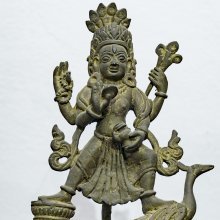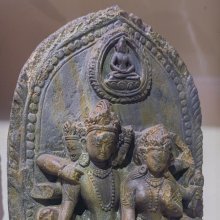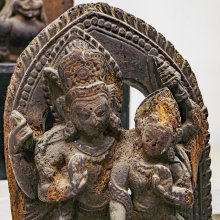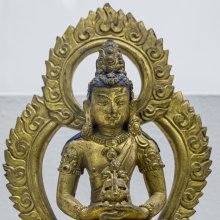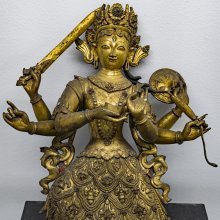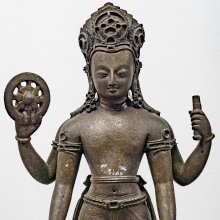Dai, Ḍaī: 12 definitions
Introduction:
Dai means something in Hinduism, Sanskrit, Marathi, Jainism, Prakrit, Hindi, biology. If you want to know the exact meaning, history, etymology or English translation of this term then check out the descriptions on this page. Add your comment or reference to a book if you want to contribute to this summary article.
Alternative spellings of this word include Daai.
Images (photo gallery)
(+1 more images available)
Biology (plants and animals)
Source: Wisdom Library: Local Names of Plants and DrugsDai [डाय] in the Marathi language is the name of a plant identified with Pleurolobus gangeticus (L.) J.St.-Hil. ex H.Ohashi & K.Ohashi from the Fabaceae (Pea) family having the following synonyms: Desmodium gangeticum, Hedysarum gangeticum. For the possible medicinal usage of dai, you can check this page for potential sources and references, although be aware that any some or none of the side-effects may not be mentioned here, wether they be harmful or beneficial to health.
Source: Google Books: CRC World Dictionary (Regional names)Dai in India is the name of a plant defined with Osbeckia nutans in various botanical sources. This page contains potential references in Ayurveda, modern medicine, and other folk traditions or local practices.
Example references for further research on medicinal uses or toxicity (see latin names for full list):
· The Flora of British India (1879)
If you are looking for specific details regarding Dai, for example pregnancy safety, health benefits, side effects, diet and recipes, chemical composition, extract dosage, have a look at these references.

This sections includes definitions from the five kingdoms of living things: Animals, Plants, Fungi, Protists and Monera. It will include both the official binomial nomenclature (scientific names usually in Latin) as well as regional spellings and variants.
Languages of India and abroad
Marathi-English dictionary
Source: DDSA: The Molesworth Marathi and English Dictionaryḍaī (डई).—f Preferably ḍhaī.
--- OR ---
ḍāī (डाई).—m f (Poetry. Pop. ḍāva) Victory or the game. At games with sōṅgaṭyā &c. Ex. mājhā ḍāī tujakaḍē rāhilā or mī tujhā ḍāī dētōṃ; also ḍāī āmucī nēdunī || ēthēṃ ālāsī paḷōnī ||. 2 A throw (of the dice): also the turn to throw. 3 Spite or malice. Used as ḍāī pēṭaṇēṃ or paḍaṇēṃ g. of o.
--- OR ---
dāī (दाई).—f ( H or P) A wet nurse. 2 A mid wife.
Source: DDSA: The Aryabhusan school dictionary, Marathi-Englishdāī (दाई).—f A wet nurse. A midwife.
Marathi is an Indo-European language having over 70 million native speakers people in (predominantly) Maharashtra India. Marathi, like many other Indo-Aryan languages, evolved from early forms of Prakrit, which itself is a subset of Sanskrit, one of the most ancient languages of the world.
Sanskrit dictionary
Source: DDSA: The practical Sanskrit-English dictionaryDai (दै).—1 P. (dāyati, dāta)
1) To purify, cleanse.
2) To be purified.
3) To protect. -With अव (ava)
1) to whiten, brighten.
2) to purify.
Source: Cologne Digital Sanskrit Dictionaries: Shabda-Sagara Sanskrit-English DictionaryDai (दै).—[(pa) daip] r. 1st cl. (dāyati) To purify or cleanse.
Source: Cologne Digital Sanskrit Dictionaries: Benfey Sanskrit-English DictionaryDai (दै).—i. 1, [Parasmaipada.] To purify.
— With the prep. ava ava, ptcple. of the pf. pass. avadāta, 1. Pure, [Lassen, Anthologia Sanskritica.] 67, 3. 2. White or yellow, [Sāvitryupākhyāna] 5, 8. 3. Dazzling white, Mahābhārata 5, 1794.
— With vyava vi-ava, pass. To spread, shining with clear light, [Daśakumāracarita] 55, 3.
Source: Cologne Digital Sanskrit Dictionaries: Monier-Williams Sanskrit-English DictionaryDai (दै):—[class] 1. [Parasmaipada] dāyati, to purify, cleanse, [Dhātupāṭha xxii, 26] (cf. √7. dā).
Source: Cologne Digital Sanskrit Dictionaries: Yates Sanskrit-English DictionaryDai (दै):—(pa) dāyati 1. a. To purify.
Sanskrit, also spelled संस्कृतम् (saṃskṛtam), is an ancient language of India commonly seen as the grandmother of the Indo-European language family (even English!). Closely allied with Prakrit and Pali, Sanskrit is more exhaustive in both grammar and terms and has the most extensive collection of literature in the world, greatly surpassing its sister-languages Greek and Latin.
Hindi dictionary
Source: DDSA: A practical Hindi-English dictionary1) Ḍāī (डाई):—(nf) a die.
2) Daī (दई):—(nm) providence; fate, destiny; see [daiyā; ~jāra] unfortunate, ill-fated (a term of abuse used generally by women); -[daī] O God ! O God; O God, save me!; ~[mārā] ill-fated; damned by Providence.
3) Dāī (दाई) [Also spelled daai]:—(nf) a midwife; nurse; ~[gīrī] midwifery; —[ko dūdha pilānā] to teach one’s grandmother to suck eggs; —[se peṭa chipānā] lit. to hide the stomach from the midwife—to keep a secret from one who is bound to know it.
...
Prakrit-English dictionary
Source: DDSA: Paia-sadda-mahannavo; a comprehensive Prakrit Hindi dictionary1) Dai (दै) in the Prakrit language is related to the Sanskrit word: Dṛti.
2) Dāi (दाइ) also relates to the Sanskrit word: Dāyin.
Prakrit is an ancient language closely associated with both Pali and Sanskrit. Jain literature is often composed in this language or sub-dialects, such as the Agamas and their commentaries which are written in Ardhamagadhi and Maharashtri Prakrit. The earliest extant texts can be dated to as early as the 4th century BCE although core portions might be older.
Nepali dictionary
Source: unoes: Nepali-English DictionaryDāi (दाइ):—n. 1. an elder brother; 2. a term of address for the senior males;
Nepali is the primary language of the Nepalese people counting almost 20 million native speakers. The country of Nepal is situated in the Himalaya mountain range to the north of India.
See also (Relevant definitions)
Starts with (+509): Daai, Dai bi, Dai ngai, Dai phong nui, Dai sua, Dai toan, Dai-nekkare, Daia, Daiang, Daicca, Daida, Daidai, Daidhishavya, Daidipyamana, Daigambara, Daigdaha, Daihik, Daihika, Daihikashikshana, Daihikasukha.
Ends with (+1273): Aadaathodai, Aalividai, Abhinamdai, Acai-nilaialapetai, Acakkiratai, Acampatai, Acariyan-tiru-atiatai, Acatai, Accatai, Accavupatai, Accinatai, Acitai, Acutai, Adadodai, Adai, Adathodai, Adatodai, Adhatodai, Adondai, Ahdan koddai.
Full-text (+218): Tayi, Manca, Dayin, Mang cau dai, Sai dai, Sa-lat-dai, Hu dai, Dai bi, Hai dai, Dai phong nui, Cu san dai, Ray dai, Avadata, Dai sua, Dai toan, Luo qun dai, Adai, Kawl dai, Daai, Dai ngai.
Relevant text
Search found 54 books and stories containing Dai, Ḍaī, Ḍāī, Dāī, Daī, Dāi; (plurals include: Dais, Ḍaīs, Ḍāīs, Dāīs, Daīs, Dāis). You can also click to the full overview containing English textual excerpts. Below are direct links for the most relevant articles:
Bhagavati-sutra (Viyaha-pannatti) (by K. C. Lalwani)
Part 2 - Types of renunciation < [Chapter 2]
Little Meera and The Param-Vir-Chakra < [July 1964]
Silence < [July – September, 1993]
Triple Stream < [April – June, 2004]
Ramayana (by Manmatha Nath Dutt)
Chapter LXXIII < [Book 1 - Bāla-kāṇḍa]
Bhajana-Rahasya (by Srila Bhaktivinoda Thakura Mahasaya)
Text 14 < [Chapter 7 - Saptama-yāma-sādhana (Pradoṣa-kālīya-bhajana–vipralambha-prema)]
Text 9 < [Chapter 5 - Pañcama-yāma-sādhana (Aparāhna-kālīya-bhajana–kṛṣṇa-āsakti)]
Trishashti Shalaka Purusha Caritra (by Helen M. Johnson)
Part 13: Sambhava’s samavasaraṇa < [Chapter I - Sambhavajinacaritra]
Part 26: Śreyāṃsa’s samavasaraṇa < [Chapter I - Śreyāṃsanāthacaritra]
Part 13: Building of the samavasaraṇa < [Chapter III - The initiation and omniscience of Ajita]
Chaitanya Bhagavata (by Bhumipati Dāsa)
Verse 1.9.41 < [Chapter 9 - Nityānanda’s Childhood Pastimes and Travels to Holy Places]
